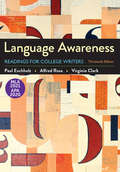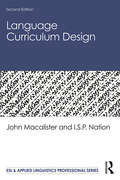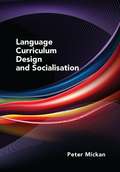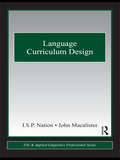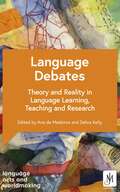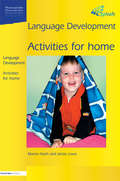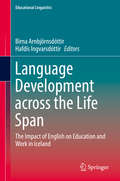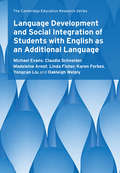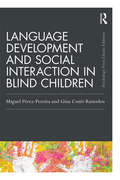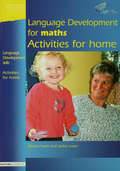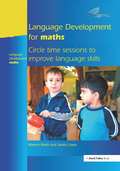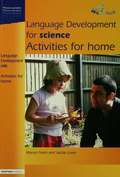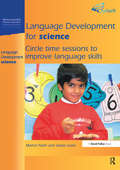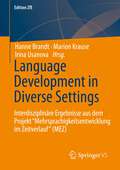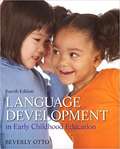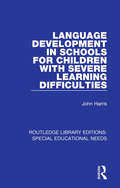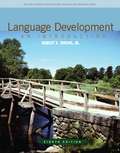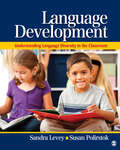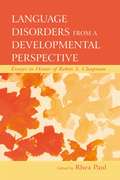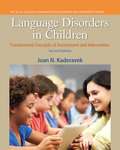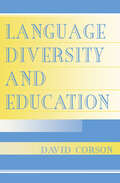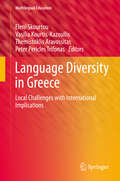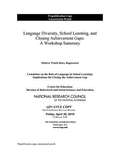- Table View
- List View
Language Awareness with 2020 APA and 2021 MLA Updates: Readings For College Writers
by Paul Eschholz Alfred Rosa Virginia ClarkThis ebook has been updated to provide you with the latest guidance on documenting sources in MLA style and follows the guidelines set forth in the MLA Handbook, 9th edition (April 2021).Explore the pervasive influence of language on our lives while becoming a better academic writer with Language Awareness.
Language Conflict in Educational Settings: International Perspectives (Routledge Research in Language Education)
by Adolfo Elizaincín Yliana V. RodríguezLanguage Conflict in Educational Settings: International Perspectives delves into the intriguing intersection of contact linguistics and education, a topic that has been relatively unexplored until now.With contributions from scholars across the globe, the book ventures into the realms of conflict linguistics in educational scenarios. Language contact, often fraught with internal and external conflicts, impacts education significantly. Drawing on scholarship representative of different locations, backgrounds, and disciplinary angles, the authors present studies of pairs and triads of different language families from across the Americas, Africa, Asia, and Europe, ultimately demonstrating how language contact leads to conflict, and how the latter eventually affects education processes and outcomes. Presenting a diverse set of theoretical perspectives and methodologies, it asks to what extent these impacts are detrimental to educational outcomes, and more specifically, how language conflict can impact education in the form of policy, teaching, and learning. As such, it provides essential insights for educators, policymakers, and professionals in the fields of education, linguistics, and cultural studies, offering valuable case studies in the under-researched field of language conflict. It ultimately contributes to the enhancement of education in language contact contexts and fosters a deeper understanding of this critical intersection.This book is an invaluable resource for researchers, scholars, and teacher-educators, offering insights to help understand such an intricate phenomenon, as well as those working across language education, linguistics, and the sociology of language more broadly.
Language Curriculum Design (ESL & Applied Linguistics Professional Series)
by John Macalister I.S.P. NationNow in its second edition, Language Curriculum Design describes the steps involved in the curriculum design process, elaborates and justifies these steps, and provides opportunities for practicing and applying them. Crystal-clear and comprehensive yet concise, the steps are laid out at a general level so that they can be applied in a wide range of particular circumstances. Updated throughout with cutting-edge research and theory, the second edition contains new examples on curriculum design and development and expanded attention on environment analysis, needs analysis, and program evaluation. The process comes to life through plentiful examples of actual applications from the authors’ experience and from published research. Each chapter also includes tasks that encourage readers to relate the steps to their own experience, and case studies and suggestions for further reading. Combining sound research/theory with state-of-the-art practice, Language Curriculum Design is widely applicable for ESL/EFL language education courses around the world.
Language Curriculum Design and Socialisation
by Peter MickanThis book applies social theory to curriculum design and sets out a program for language curriculum renewal for the 21st Century. It includes many examples of text-based curricula and describes a plan for curriculum renewal based on these texts as the unit of analysis for planning, for teaching and for assessment. Underpinned by Halliday's semiotic theory of language, the book combines the theory of language as a resource for meaning-making with learning language as learning to mean. The curriculum design constructs curriculum around social practices and their texts rather than presenting language as grammatical and lexical objects. This work will provide teachers, teacher educators and curriculum planners with a curriculum model for teaching children and adults in different contexts from preschool to adult education as well as serving as a practical guide for students.
Language Curriculum Design: Concepts And Approaches In Action Around The World (ESL & Applied Linguistics Professional Series)
by John Macalister I.S.P NationCrystal-clear and comprehensive yet concise, this text describes the steps involved in the curriculum design process, elaborates and justifies these steps, and provides opportunities for practicing and applying them. The description of the steps is done at a general level so that they can be applied in a wide range of particular circumstances. The process comes to life through plentiful examples of actual applications of the steps. Each chapter includes: examples from the authors' experience and from published research tasks that encourage readers to relate the steps to their own experience case studies and suggestions for further reading that put readers in touch with others' experience Curriculum, or course, design is largely a 'how-to-do-it' activity that involves the integration of knowledge from many of the areas in the field of Applied Linguistics, such as language acquisition research, teaching methodology, assessment, language description, and materials production. Combining sound research/theory with state-of-the-art practice, Language Curriculum Design is widely applicable for ESL/EFL language education courses around the world.
Language Debates: Theory and Reality in Language Learning, Teaching and Research (Language Acts and Worldmaking #1)
by VariousThis book captures an urgent moment for language teaching, learning and research. At its core are a series of debates concerning gender stereotyping, the place of linguistics in modern languages, language activism, multilingualism and modern languages and digital humanities. Taken together, these debates explore the work that languages, and that those who learn and speak them, do in the world as well as the way we think 'through' and 'in' a language and are shaped by it. Language Debates acknowledges the history of language teaching and the current realities of language teaching and learning. It is bold in suggesting ways forward for reform and for policy, setting languages and language learning at the heart of a consciously transformative set of goals. This book is therefore essential reading for academics, language teachers, policy makers, students, activists and those passionate about progressing language learning and teaching. The editors and contributors make up a multilingual and multicultural team who work across languages, cultures and borders with a globally-informed approach to their work. Uniquely, the debates in this volume are based on events with participants in the Language Acts and Worldmaking Debates Series and/or workshops within the wider research project and take into account the ensuing discussions there. Each debate is accompanied by an interview which serves as a model on how to continue the conversation beyond the printed pages of the book. You can also discover ways to join the debate through links on the Language Acts and Worldmaking series website (www.jmlanguages.com/languageacts) which includes recorded debates, additional materials and more information about the series. Like all the volumes in the Language Acts and Worldmaking series, the overall aim is two-fold: to challenge widely-held views about language learning as a neutral instrument of globalisation and to innovate and transform language research, teaching and learning, together with Modern Languages as an academic discipline, by foregrounding its unique form of cognition and critical engagement. Specific aims are to:· propose new ways of bridging the gaps between those who teach and research languages and those who learn and use them in everyday contexts from the professional to the personal· put research into the hands of wider audiences · share a philosophy, policy and practice of language teaching and learning which turns research into action· provide the research, experience and data to enable informed debates on current issues and attitudes in language learning, teaching and research· share knowledge across and within all levels and experiences of language learning and teaching· showcase exciting new work that derives from different types of community activity and is of practical relevance to its audiences · disseminate new research in languages that engages with diverse communities of language practitioners.
Language Debates: Theory and Reality in Language Learning, Teaching and Research (Language Acts and Worldmaking #1)
by VariousThis book captures an urgent moment for language teaching, learning and research. At its core are a series of debates concerning gender stereotyping, the place of linguistics in modern languages, language activism, multilingualism and modern languages and digital humanities. Taken together, these debates explore the work that languages, and that those who learn and speak them, do in the world as well as the way we think 'through' and 'in' a language and are shaped by it. Language Debates acknowledges the history of language teaching and the current realities of language teaching and learning. It is bold in suggesting ways forward for reform and for policy, setting languages and language learning at the heart of a consciously transformative set of goals. This book is therefore essential reading for academics, language teachers, policy makers, students, activists and those passionate about progressing language learning and teaching. The editors and contributors make up a multilingual and multicultural team who work across languages, cultures and borders with a globally-informed approach to their work. Uniquely, the debates in this volume are based on events with participants in the Language Acts and Worldmaking Debates Series and/or workshops within the wider research project and take into account the ensuing discussions there. Each debate is accompanied by an interview which serves as a model on how to continue the conversation beyond the printed pages of the book. You can also discover ways to join the debate through links on the Language Acts and Worldmaking series website (www.jmlanguages.com/languageacts) which includes recorded debates, additional materials and more information about the series. Like all the volumes in the Language Acts and Worldmaking series, the overall aim is two-fold: to challenge widely-held views about language learning as a neutral instrument of globalisation and to innovate and transform language research, teaching and learning, together with Modern Languages as an academic discipline, by foregrounding its unique form of cognition and critical engagement. Specific aims are to:· propose new ways of bridging the gaps between those who teach and research languages and those who learn and use them in everyday contexts from the professional to the personal· put research into the hands of wider audiences · share a philosophy, policy and practice of language teaching and learning which turns research into action· provide the research, experience and data to enable informed debates on current issues and attitudes in language learning, teaching and research· share knowledge across and within all levels and experiences of language learning and teaching· showcase exciting new work that derives from different types of community activity and is of practical relevance to its audiences · disseminate new research in languages that engages with diverse communities of language practitioners.
Language Development 1a: Activities for Home
by Marion Nash Jackie LoweFirst Published in 2005. Routledge is an imprint of Taylor & Francis, an informa company.
Language Development across the Life Span
by Birna Arnbjörnsdóttir Hafdís IngvarsdóttirThis book offers insights from a seven-year study into the impact of English as an International Language at a national level, from the effect of rich English input on a previously monolingual people’s linguistic repertoire to its effect on the situated language use demanded of speakers who find themselves in a new linguistic environment for which they have not been prepared. The changes described in the book have occurred in a speech community that identifies strongly with the local language, but finds itself increasingly having to use another language to perform daily functions in education and work. Findings describe how the official language and educational policies have not addressed this new linguistic ecology of Iceland. The findings of these studies have larger international practical, educational, empirical, and theoretical implications and should be relevant to anyone interested in in the impact of English as an International Language.
Language Development and Social Integration of Students with English as an Additional Language (Cambridge Education Research)
by Michael Evans Linda Fisher Madeleine Arnot Claudia Schneider Karen Forbes Yongcan Liu Oakleigh WelplyGiven the current context of the experience of migration on schools in England and Europe, and the competing policies and approaches to social integration in schools, there is a need to understand the connection between language development and social integration as a basis for promoting appropriate policies and practices. This volume explores the complex relationship between language, education and the social integration of newcomer migrant children in England, through an in-depth analysis of case studies from schools in the East of England. The authors set this evidence against the background of policy debates in the wider international setting, including a critical discussion of assumptions underlying national narratives of mainstreaming and assimilation. In the light of an absence of national guidelines for appropriate practice in schools, the authors outline a model of inclusive pedagogy for English as an additional language (EAL) and a framework of home-school communication to promote effective EAL parental engagement in schools.
Language Development and Social Interaction in Blind Children (Psychology Press & Routledge Classic Editions)
by Gina Conti-Ramsden Miguel Perez-PereiraThe Classic Edition of this foundational text includes a new preface from Miguel Pérez-Pereira, examining how the field has developed since first publication. The volume provides an in-depth account of blind children's developing communicative abilities, with particular emphasis on social cognition and language acquisition from infancy to early school age. It provides insights into why the development of blind children may differ from that of sighted children and explores development of "theory of mind" and perspective taking in language learning. It also discusses the caregiver–child interaction, research on early intervention and practical strategies for blind children that can assist parents and practitioners. The up-to-date preface discusses recent neurological research and the comparison between the psychological development of visually impaired and autistic children. Language Development and Social Interaction in Blind Children continues to facilitate dialogue between those interested in the study of typically developing children and those interested in the development of children who are blind, and challenges some widely held beliefs about the development of communication in blind children.
Language Development for Maths: Activities for Home
by Marion Nash Jackie LoweBuilding upon the successful 'spirals' programme this series of books addresses language development in three core areas of the curriculum. Linking the work done in school with the simple games and activities to be used at home. All activities have been tried and tested - proven effectiveness. the video CD with teachers' book contains explanations and demonstrations of the programme and its implementation, with comments from the staff who have used it.
Language Development for Maths: Circle Time Sessions to Improve Communication Skills in Maths
by Marion Nash Jackie LoweBuilding on the successful 'spirals' programme this series of books addresses language development in the three core areas of the curriculum. Linking the work done in school with simple games and activities to be used at home. All activities have been tried and tested - proven effectiveness. A video CD contains explanation and demonstration of the programme and its implementation, with commetns from staff who have used it.
Language Development for Science: Activities for Home
by Marion Nash Jackie LoweThese simple play-based activities are ideal for teachers to copy and give out to parents who want to know how to help their child improve his or her science language skills and have fun at the same time. Activities are linked directly to the school-based Language Development Circle Time sessions, but can also be used independently. There is a clear structure and progression of ideas, with supporting black-line drawings to acts as prompts and simple record - keeping system to support home/school communication.
Language Development for Science: Circle Time Sessions to Improve Language Skills
by Marion Nash Jackie LoweThis book is the first of its kind to help practitioners specifically develop children's language skills in Science. The book incudes: guidelines to help teachers set up, run and assess circle-time sessions ideas for promoting children's thinking skills and emotional literacy video CD containing explanation and demonstration of the programme and its implementation, with comments from staff who have used it.
Language Development in Diverse Settings: Interdisziplinäre Ergebnisse aus dem Projekt "Mehrsprachigkeitsentwicklung im Zeitverlauf“ (MEZ) (Edition ZfE #11)
by Hanne Brandt Marion Krause Irina UsanovaDer Band präsentiert interdisziplinäre Befunde zur Relevanz von Mehrsprachigkeit für die Bildungsbiografien von Schülerinnen und Schülern in Deutschland. Im Fokus stehen sprachliche, persönliche und kontextuelle Faktoren, die die sprachliche Entwicklung von Lernenden beeinflussen können. Dabei kommen sowohl quantitative als auch qualitative Methoden zum Einsatz.
Language Development in Early Childhood Education
by Beverly W. OttoWritten by Beverly Otto, Language Development in Early Childhood Education, 4/e efficiently combines theory, research, and practice to provide a solid foundation for understanding language development in children birth through age eight. A comprehensive resource, it focuses on the development of phonological, semantic, syntactic, morphemic, and pragmatic language skills, children's understanding of written language, and ways in which this acquisition process can be enhanced in early childhood settings. Exact guidance on how to develop classrooms and other learning environments that enhance children's language development is also provided. Every chapter begins with interesting vignettes of young children's language development, and throughout all the chapters, readers will discover anecdotal narratives to illustrate key concepts and interaction strategies.
Language Development in Schools for Children with Severe Learning Difficulties (Routledge Library Editions: Special Educational Needs #31)
by John HarrisFirst published in 1988. Language is an important developmental ability which facilitates communication both at home and at school. It is also the foundation of many of a child’s learning experiences in school. A certain level of language is often a pre-requisite both for success in particular curriculum areas and for the ability to conceptualise generally. Language developing is thus a major concern for those who work with mentally handicapped children and it has come to be regarded as one of the main objectives within the special school curriculum. This book is concerned with the opportunities for language learning which special schools make available for severely mentally handicapped children. It describes how special schools seek to meet the very diverse needs of their pupils and provides a discussion of the success of contemporary approaches to encouraging language development. The author makes a number of constructive criticisms and suggestions for improving practice which should interest anyone whose work involves teaching children with severe learning difficulties.
Language Development: An Introduction (Eighth Edition)
by Robert E. OwensThis leading and comprehensive text on language development is rich in information, research, examples, and activities. A thorough and readable introductory text on language development, this book covers all aspects of the complex subject -- including syntax, morphology, semantics, phonology, and pragmatics -- while explaining each idea and concept in a way that is easily understandable by even beginning students of the field. Rich in pedagogical aids like discussion questions, chapter objectives, reflections, and main point boxed features, the eighth edition of Language Development also emphasizes culturally and linguistically diverse children and bilingual and dialectical developmental information -- a discussion that accurately reflects the diversity of life and language in the United States.
Language Development: Understanding Language Diversity in the Classroom
by Sandra Levey, Susan PolirstokPrepares future and current teachers to understand language development, differences, and disorders—and the factors that lead to classroom success Language Development: Understanding Language Diversity in the Classroom offers comprehensive coverage of the language development process for pre- and in-service teachers while emphasizing the factors that further academic success in the classroom, including literacy skills, phonological awareness, and narrative. With chapters written by respected specialists in various fields, this interdisciplinary text illuminates the impact of language development on learning success and distinguishes between language differences and disorders, integrating illustrative case studies as well as helpful classroom strategies that teachers can implement right away.
Language Disorders From a Developmental Perspective: Essays in Honor of Robin S. Chapman (New Directions in Communication Disorders Research)
by Rhea PaulThe last 25 years have witnessed an explosion of research at the intersection of typical language development and child language disorders. A pioneer in bringing these fields of study together is Robin S. Chapman, Emerita, University of Wisconsin. This contributed volume honors her with chapters written by former students and colleagues, who track in their own research the theme of psycholinguistic contributions to our understanding of the nature and remediation of child language disorders. In this volume, such renowned researchers in child language development as Dorothy Bishop, Judith Johnston, and Ray Kent, among others, discuss their research in certain populations in the context of the significance of, limits of, and alternatives to Robin Chapman’s developmental interactionist perspective. Studies of disordered language in Down’s Syndrome and Specific Language Impairment, in particular, attribute much progress in our understanding of the pragmatic and comprehension skills in these populations to the developmental perspective. Language Disorders From a Developmental Perspective opens with a reprint of Robin Chapman’s seminal 2001 article from The Journal of Child Psychiatry and Psychology. It concludes with a new chapter from Dr. Chapman summarizing what we know and what we don’t know about language disorders within the developmental framework, and pointing to future areas of research and intervention. Clinicians as well as scholars will benefit from this book, as will students in programs of developmental psycholinguistics, child language disorders, and learning disabilities.
Language Disorders in Children: Fundamental Concepts of Assessment and Intervention
by Joan N. KaderavekThis text is more than an introductory look at language disorders. It goes beyond basic concepts and basic definitions to teach students how to analyze, synthesize, evaluate, and link the information they are learning. It offers readers opportunities for higher-order learning, while preparing students to become careful evaluators of information, as well as adept problem solvers. Organized by disorder groups and theme, Language Disorders in Children, 2/e helps students easily make connections between theoretical information and clinical practice through a number of thoughtful features such as case histories, clinical decision trees, and hot topic discussions. It's an approach that meets the needs of today's students to learn lifetime critical thinking skills, to see relationships between isolated ideas and facts, and to think like a speech-language pathologist.
Language Diversity and Education
by David CorsonThis introductory text for students of linguistics, language, and education provides background and up-to-date information and resources that beginning researchers need for studying language diversity and education. Three framing chapters offer an update on the philosophy of social research, revealing how important language is for all the processes of learning in which humans engage, whether it is learning about the world through education, or learning about the nature of social life through research in the human sciences. These chapters also review the links between language, power, and social justice, and look at dynamic changes occurring in "language diversity and education" research. Four central chapters give state-of-the-art, comprehensive coverage to the chief areas of language diversity that affect the practice of education: standard and non-standard varieties; different cultural discourse norms; bilingual and ESL education; and gendered discourse norms. This book is intended for graduate students of applied linguistics, sociolinguistics, psycholinguistics, the social psychology of language, anthropological linguistics, and other related disciplines; and graduate students of education, including in-service teachers taking advanced professional development courses. Special features enhance its usefulness as a text for courses in these areas: * A clear, jargon free writing style invites careful reading. * All ideas are well within the range that graduate students in the language disciplines or in education can relate to their work, but theoretical ideas are kept to a necessary minimum and linked with practical examples in every case. * Extensive references guide readers to the book's up-to-date, international, and cross-cultural bibliography. * "Discussion Starter" questions at the end of each chapter highlight key points and stimulate informed, reflective discussion.
Language Diversity in Greece: Local Challenges with International Implications (Multilingual Education #36)
by Peter Pericles Trifonas Themistoklis Aravossitas Vasilia Kourtis-Kazoullis Eleni SkourtouThis volume explores how linguistic and cultural diversity in Greece, caused by various waves of emigration and immigration, has transformed Greek society and its educational system. It examines the country’s current linguistic diversity, which is characterised by the languages of immigrants, repatriates, refugees, Roma, Muslim minorities, and Pomaks as well as linguistic varieties and dialects; and how schools and the state have designed and implemented programmes to deal with the significant educational challenges posed by these culturally and linguistically diverse groups. In this regard, the book takes into account the nature and evolution of Greek society; Greece’s traditional role as a labour-exporting country with a long history of migration to other countries; and major political, economic and social developments, such as the collapse of communism, the opening of borders in Eastern Europe, and the influx of immigrants from Muslim countries.
Language Diversity, School Learning, and Closing Achievement Gaps: A Workshop Summary
by National Research Council of the National AcademiesThe Workshop on the Role of Language in School Learning: Implications for Closing the Achievement Gap was held to explore three questions: What is known about the conditions that affect language development? What are the effects of early language development on school achievement? What instructional approaches help students meet school demands for language and reading comprehension? Of particular interest was the degree to which group differences in school achievement might be attributed to language differences, and whether language-related instruction might help to close gaps in achievement by helping students cope with language-intensive subject matter especially after the 3rd grade. The workshop provided a forum for researchers and practitioners to review and discuss relevant research findings from varied perspectives. The disciplines and professions represented included: language development, child development, cognitive psychology, linguistics, reading, educationally disadvantaged student populations, literacy in content areas (math, science, social studies), and teacher education. The aim of the meeting was not to reach consensus or provide recommendations, but rather to offer expert insight into the issues that surround the study of language, academic learning, and achievement gaps, and to gather varied viewpoints on what available research findings might imply for future research and practice. This book summarizes and synthesizes two days of workshop presentations and discussion.
